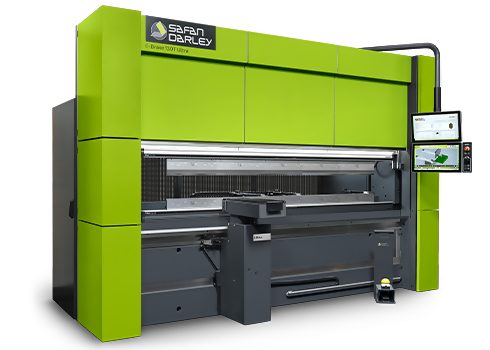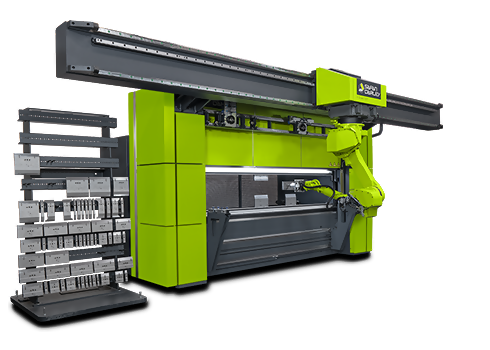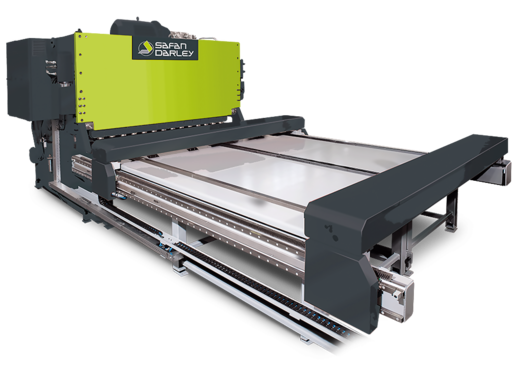
Production Efficiency - Ram Speed

Production Efficiency > RamSpeed: 3 Ways Smart Automation and Bend Speed Optimization Maximize ROI
Ram speed is a performance characteristic that gets a lot of attention in the press brake industry. While it is an important component of a machine’s potential productivity, ram speed doesn’t tell the whole story.
The ram’s vertical movement is only one brief motion that occurs within a much longer automation process, and focusing solely on that feature can distort the top-line analysis of how much a given press brake can produce – in other words, ROI.
Sheet metal fabricators are wise to focus on ROI because press brakes are critical investments that factor heavily into profitability. It is the overall production efficiency of each machine – not simply the ram speed – that determines how much metal it can bend.
The bend speed optimization designed into SafanDarley’s press brakes provides a level of safety and production efficiency that is unmatched by our competitors, even those who quote faster ram speeds.
Here are three reasons why smart automation and bend speed optimization deliver a higher ROI than traditional press brakes that only focus on accelerating ram speeds:
Safety
SafanDarley press brakes are designed to protect operators and, by extension, the companies that employ them. Simply put, press brake accidents can have devastating consequences for people and employers. Mere fractions of a second gained by unsafe equipment that simply moves faster are quickly lost in the event of an injury and the fallout to follow.
Our equipment is designed with operator safety and ergonomics at the forefront. SafanDarley’s revolutionary light curtain, which is motion-activated and fully integrated into each press brake’s controls, virtually eliminates the most common injuries associated with operating press brakes. It’s important to note that the press brake defaults to motion and automatically releases when the operator’s hands exit the curtain. (Any time gained with a faster ram speed is likely offset by the second it takes for the operator to manually activate a press break that doesn’t use a light curtain.)
Once released, the ram proceeds with bending metal at the maximum safe speed for each particular fabrication job. Rather than simply making the ram move faster regardless of the complexities of any given fabrication, SafanDarley equipment calculates bend speed optimization based on all the variables for each individual project.
Operator safety is paramount in the bend speed optimizations selected for each fabrication job, and no dollar figure begins to measure the value of protecting your employees and your business.
Accelerated Bending Cycle Time
The bending cycle time is the time it takes for a press brake to fabricate a part, from initiation of the bend through completion and the initiation of the next bend. The overall cycle time includes all of the other actions that happen before and after the ram moves.
Cycle time is affected by a range of factors including user interface (does the operator know what to do), ergonomics, robot functionality, efficiency in tooling and loading materials, ram speed, and the picking and stacking time once the new part has been fabricated. SafanDarley’s line of press brakes is designed to maximize efficiency and reduce the bending cycle time throughout the bending cycle, across each of these steps. The result is a high level of efficiency without compromising safety.
When the production cycle is considered as a whole (not just ram speed), SafanDarley's technology is 30% faster than conventional press brakes.
Reduced Setup and Programming Time
Fabricators should not overlook the time it takes to program every fabrication job. Programming time can absolutely hit your bottom line by tying up operators’ valuable time while keeping your machinery tied up longer between jobs. Much more time can be saved (or lost) in this step than perhaps any other step in the fabrication process.
If your operators are manually programming jobs into your press brakes on the shop floor, you can reap significant savings with offline programming. AutoPOL, our CAD/CAM-compatible offline 3D programming software, makes it possible to program multiple jobs from a laptop computer (not on the shop floor) in advance, so each job can be programmed quickly with minimal downtime between jobs.
AutoPOL accelerates the production cycle and reduces inefficiencies by producing correct cut blanks (DXF files) on the first try and deploying them to the laser or nesting software. The software creates the DXF blanks taking the press brake’s actual tooling into account and uses the correct K-factors and bend allowances for that configuration.
This automation accelerates setup and eliminates wasted time and materials caused by manual, trial-and-error approaches to figuring out the correct flat pattern and tooling for each project.
Ram Speed Is Only Part of the Equation
Ram speed is important, but no more so than all of the other elements that must work together efficiently to maximize your operation’s production.
To understand a given press brake’s potential ROI, fabricators should consider the safety, entire bending cycle time, and setup requirements of each machine, as those factors will determine how much metal it can bend in a given year.
Read more
blogs
Technology and automation are changing sheet metal fabrication at a blistering pace. Innovations like Autopol software for offline press brake programming are changing the game, and it’s natural for them to get a lot of press. However, relationships still matter in our industry. In fact, I would say that partnering with the right OEM is as important now as ever.
Your facility’s production floor is the heart of your operation. It’s the hallowed ground between the front office, where orders come in and deals are made, and the loading dock, where you ship goods to market. The shop floor is where you make your money, and sheet metal fabricators are wise to maximize the production value for every square inch of that space. Read here the three important, space-related questions to ask when choosing your equipment.


















